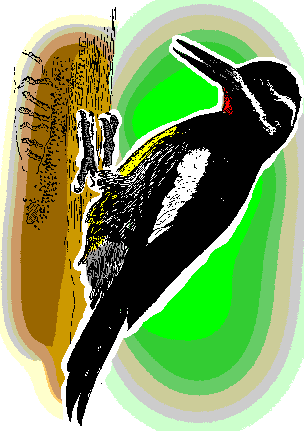Adapted from Jim Conrad's online book A Birding Trip through Mexico, This excerpt from "The Pine Forest of Lake Arareko" near Copper Canyon
A MIXED-SPECIES FLOCK
During most of the morning and then again in late afternoon the mixed-species flock of my first morning's awakening floats up and down the little valley below my tent, the White-breasted Nuthatch's nasal yank-yank-yank always announcing the flock's location. As I approach the yank-yank-yank other calls become apparent and a flurry of silhouettes of small, hyperactive birds appears among the pines' lower branches.
At the heart of the flock are five White-breasted Nuthatches, only one of which is calling. Also there are three or four Ruby-crowned Kinglets -- none showing a hint of a ruby crown -- and three or four Mexican Chickadees. These species are among the smallest of the forest and they all flit nervously from branch to branch, probing with their tiny, slender bills into open pine cones, clusters of pine needles, and any irregularity of bark or twig, foraging for very small insects, spiders, and other arthropods.
There's been a good bit of study on mixed-species flocks such as this one. Flocks can consist of as few as two species, or more than a dozen. Some flocks are semipermanent, others are dissolved and reformed at more or less regular intervals, and some are completely transitory. They can be very loosely organized, or tightly integrated with complicated social structures. Their abundance and complexity is greatest in the humid tropics.
It's easy to imagine that a flock of flitting birds is more likely to jar a spider from beneath its leaf, or cause a bug to run from cover, than a single bird. However, woodpeckers often join such flocks, and their prey resides unshakably beneath flakes of tree bark. Also, we saw among the Mesquite that grain-eating birds also form mixed-species flocks. More than one serious ornithologist have suggested that often birds of different species flock together just for the company.
From time to time other bird species are drawn into my present flock's general vicinity but they do not join the active nucleus, just remain loosely on the periphery. After a few minutes the wandering flock drifts on without the visitors, or else the visitors fly away, abandoning the flock altogether. Among such visitors are Northern Flickers, Williamson's Sapsucker (shown below), and a single Yellow-eyed Junco with its eerie, schoolbus-yellow eyes.

Mixed-species flocks of nuthatches, chickadees, and titmice often flock together during the winter in North America and Europe. I was thinking about this when it occurred to me that, if I were in Kentucky with such a mixed flock, very nearby there would almost certainly be a Brown Creeper hopping up and down tree trunks, probing bark fissures and beneath loose bark flakes for miniscule arthropods.
As soon as this thought comes to mind, perfectly timed, a familiar, very high, thin seeeeep call of a Brown Creeper filters among the big pines.